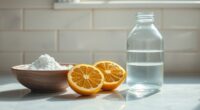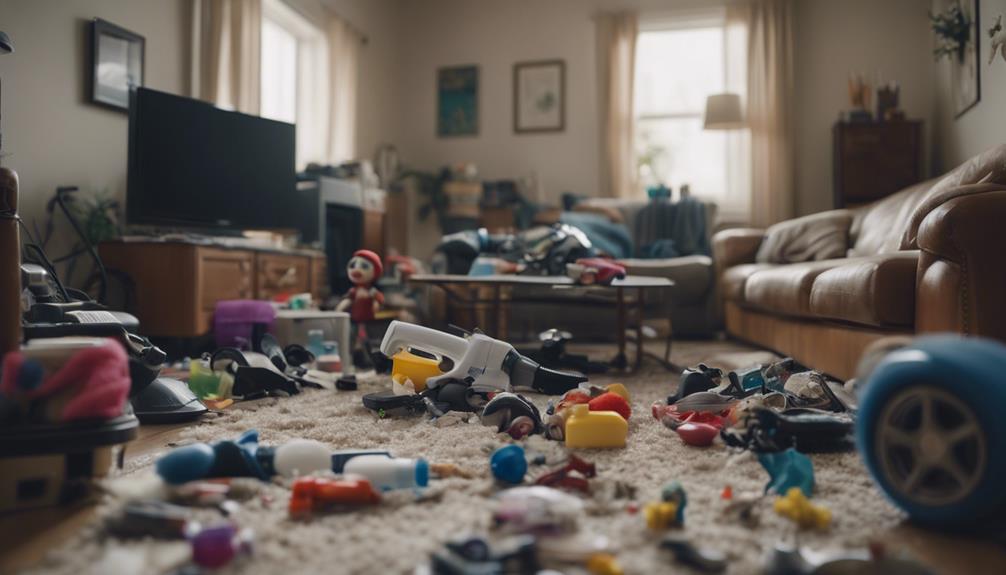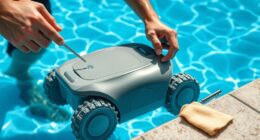Mineral buildup forms from hard water, which contains high levels of calcium and magnesium. When water evaporates, it leaves behind these minerals, leading to stubborn stains and deposits. This buildup can also harm your appliances and plumbing, reducing efficiency and increasing energy costs. To remove it, you can use natural solutions like vinegar or citric acid, along with regular maintenance practices. Discovering more about the effects and prevention can help you keep your home in top shape.
Key Takeaways
- Mineral buildup, or limescale, forms from calcium and magnesium deposits left by hard water evaporation, affecting 85% of U.S. households.
- High temperatures cause soluble calcium bicarbonate to decompose into insoluble calcium carbonate, leading to persistent limescale.
- Signs of mineral buildup include white deposits, decreased water flow, cloudy glass, and stained dishes.
- Effective removal methods include vinegar soaks, citric acid cleaning, and regular scrubbing with non-abrasive pads.
- Preventive measures like installing water softeners and consistent cleaning can significantly reduce mineral buildup and improve appliance efficiency.
Understanding Mineral Buildup: What Is It?
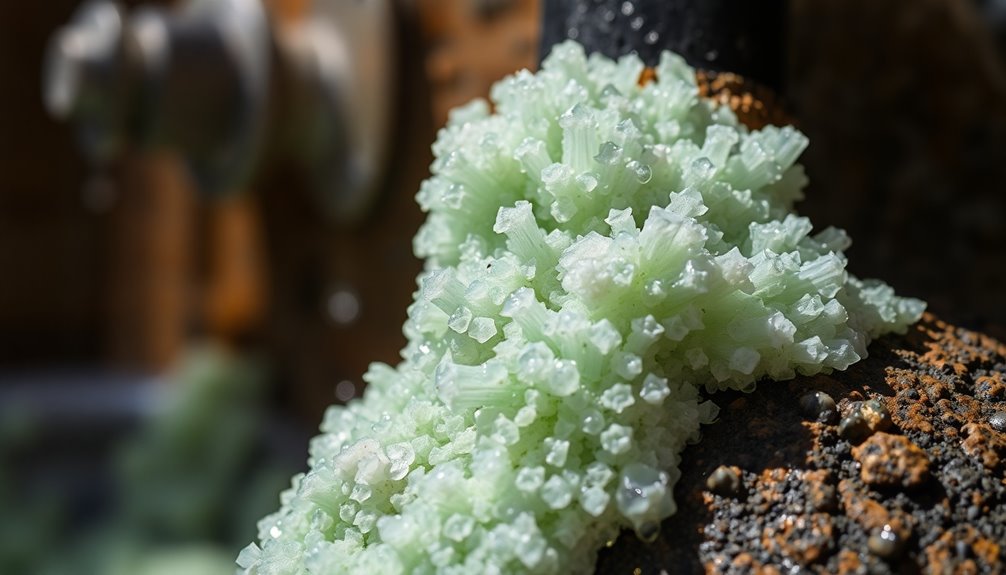
Mineral buildup, often seen as an unsightly nuisance, is primarily caused by calcium and magnesium deposits left behind when hard water evaporates.
This buildup, commonly referred to as limescale, occurs when high temperatures cause soluble calcium bicarbonate to decompose into insoluble calcium carbonate.
With about 85% of the U.S. experiencing hard water, you might notice these mineral deposits accumulating on faucets, glass shower doors, and other surfaces.
Once formed, these deposits can bond firmly, making them difficult to remove without regular maintenance.
Ignoring mineral buildup can lead to severe staining and clogging in your plumbing systems and appliances.
Recognizing the signs early can help you take action and maintain a clean, functional environment. Additionally, using water air purifiers can help reduce mineral deposits by effectively trapping dust and allergens.
The Chemistry of Hard Water: Causes of Mineral Accumulation

Hard water is made up of dissolved minerals, mainly calcium and magnesium, which can lead to pesky mineral buildup in your home.
When water evaporates, it leaves behind these minerals, forming unsightly deposits on your fixtures and appliances.
Understanding the chemistry behind hard water helps you tackle the accumulation and prevent further damage. Additionally, using dry, seasoned wood in a wood stove can help improve indoor air quality, which may reduce the effects of mineral buildup in your home.
Hard Water Composition Explained
Water's composition plays an essential role in determining its quality and usability. Hard water contains high levels of dissolved minerals, primarily calcium (Ca²⁺) and magnesium (Mg²⁺) ions.
When these minerals exceed 60 parts per million (ppm), you're likely to encounter hard water stains and mineral deposits in your home.
Temporary hardness stems from calcium and magnesium bicarbonates, which can be eliminated by boiling. In contrast, permanent hardness, caused by sulfates, remains even after boiling.
As hard water is heated, it can lead to limescale formation, as calcium bicarbonate decomposes into calcium carbonate, resulting in stubborn buildup. Understanding this composition helps you address issues like limescale removal and maintain your plumbing systems effectively. Additionally, utilizing energy-efficient systems can contribute to reducing overall energy demand while managing hard water issues.
Mineral Precipitation Mechanisms
Understanding how hard water leads to mineral buildup is key to addressing the issues it causes.
Mineral precipitation occurs when dissolved minerals like calcium and magnesium exceed their solubility limits, often due to increased temperature or changes in water chemistry. As water evaporates or heats up, calcium bicarbonate breaks down into calcium carbonate, forming limescale deposits.
High pH levels, especially above 7, further promote this conversion, resulting in more persistent deposits. Repeated exposure to hard water allows these minerals to bond tightly to surfaces, making removal difficult. Additionally, air quality can be impacted by mineral buildup in appliances that use water, as it can lead to decreased efficiency and increased maintenance needs.
Factors such as water temperature, pressure, and contact duration greatly influence the rate of mineral precipitation, ultimately affecting your water quality and the maintenance needed to keep surfaces clean.
Impact on Household Surfaces
Mineral buildup on household surfaces can be a frustrating issue, especially when you notice unsightly stains and deposits. This problem primarily arises from water hardness, where high levels of calcium and magnesium lead to limescale deposits.
Here are three impacts you might experience:
- Stubborn Stains: Hard water can leave behind chalky residues on bathroom surfaces, making them look dingy.
- Increased Maintenance: Cleaning becomes more challenging, as prolonged contact with hard water allows minerals to bond more firmly to surfaces.
- Damage Over Time: If left untreated, limescale can degrade materials like glass and porcelain, leading to costly repairs.
To minimize these effects, promptly dry your surfaces after contact with water. This simple step reduces evaporation and helps prevent mineral deposits. Additionally, using a HEPA filter in your air purifier can help capture airborne dust and allergens that may exacerbate the appearance of mineral buildup.
How Hard Water Leads to Stains and Deposits

When hard water flows through your home, it carries with it high levels of dissolved minerals like calcium and magnesium. As the water evaporates, these minerals precipitate out, leaving behind unsightly stains and white, chalky deposits. You'll likely notice them on faucets, sinks, and shower doors. Over time, the accumulation of calcium deposits leads to limescale build-up that can bond firmly to surfaces, making removal a challenge. Temperature also plays a role; heating hard water speeds up the formation of these deposits. With approximately 85% of U.S. water being hard, it's essential to tackle this issue promptly. Regular cleaning routines can support a healthier lifestyle by minimizing the impact of hard water stains.
| Issue | Effect | Solution |
|---|---|---|
| Hard Water | Stains and deposits | Regular cleaning |
| Calcium Deposits | Difficult to remove | Use vinegar or acid |
| Limescale Build-up | Damages surfaces | Preventative measures |
The Effects of Mineral Buildup on Appliances and Plumbing

Mineral buildup can seriously impact your appliances and plumbing.
You might notice that your kettle or water heater isn't working as efficiently, which can lead to increased energy bills.
Additionally, limescale can restrict water flow in your pipes, causing pressure drops and potential clogs. Regular maintenance and cleaning can help prevent water efficiency issues associated with mineral buildup.
Appliance Efficiency Decline
As appliances work hard to deliver hot water or heat food, the hidden threat of mineral buildup can greatly undermine their efficiency.
Here's how mineral deposits affect your appliances:
- Heat Transfer: Just a quarter inch of limescale can reduce appliance efficiency by up to 40%, leading to longer heating times.
- Water Flow: Buildup obstructs plumbing, causing decreased water pressure and potential blockages.
- Appliance Lifespan: Sensitive components are damaged over time, leading to costly repairs and replacements.
Using a water softener can help prevent these issues. Regular maintenance and descaling are essential to remove limescale and preserve your appliances' performance, ultimately saving you money on utility bills. Additionally, consistent maintenance of your appliances can further enhance their efficiency and longevity.
Don't let mineral buildup hold back your home's efficiency!
Increased Energy Consumption
Though you mightn't notice it at first, mineral buildup can greatly increase your energy consumption.
Limescale, a common form of mineral deposits, insulates heating elements in appliances like water heaters, forcing them to work harder. Just a quarter inch of buildup can boost energy consumption by up to 40%.
As limescale accumulates, it reduces effective heat transfer, making your appliances inefficient and driving up your energy bills. Additionally, if mineral deposits clog plumbing systems, it can raise pressure and further increase energy costs.
Regular maintenance and descaling can restore efficiency, lower energy consumption, and extend the lifespan of your appliances. Regular filter cleaning of air purifiers can also prevent buildup and ensure optimal performance.
Addressing limescale not only saves money but also minimizes operational noise in your home.
Plumbing Flow Reduction
Limescale buildup doesn't just impact energy consumption; it also disrupts the flow of water in your plumbing system.
When mineral deposits accumulate, you can face significant issues, including:
- Diminished Water Pressure: Restricted water flow can make daily tasks like showering or washing dishes frustrating.
- Appliance Inefficiency: Dishwashers and water heaters struggle to function properly, leading to increased wear and tear.
- Potential Clogs: Over time, limescale can create blockages that require costly repairs or replacements.
To combat these effects, consider water softening solutions and regular maintenance. Additionally, investing in home security systems can help protect your home while you focus on plumbing issues.
By addressing mineral buildup proactively, you'll help maintain ideal water flow and prolong the life of your plumbing and appliances.
Don't wait until it's too late—take action now!
Recognizing Signs of Mineral Buildup in Your Home

Mineral buildup can sneak up on you, often hiding in plain sight. Look for white, chalky mineral deposits on your plumbing fixtures, like faucets and showerheads, which indicate the presence of calcium and magnesium ions.
You might notice decreased water flow, a sign that your pipes or showerheads are clogged with these accumulated deposits.
Check your glass surfaces, too; if they appear cloudy or streaky, it's likely due to mineral etching from hard water.
Stains on dishes and glassware after washing are another red flag, resulting in a dull finish that demands extra cleaning.
Staying vigilant about these signs can help you address mineral buildup before it leads to further damage in your home.
Effective Methods for Removing Mineral Deposits
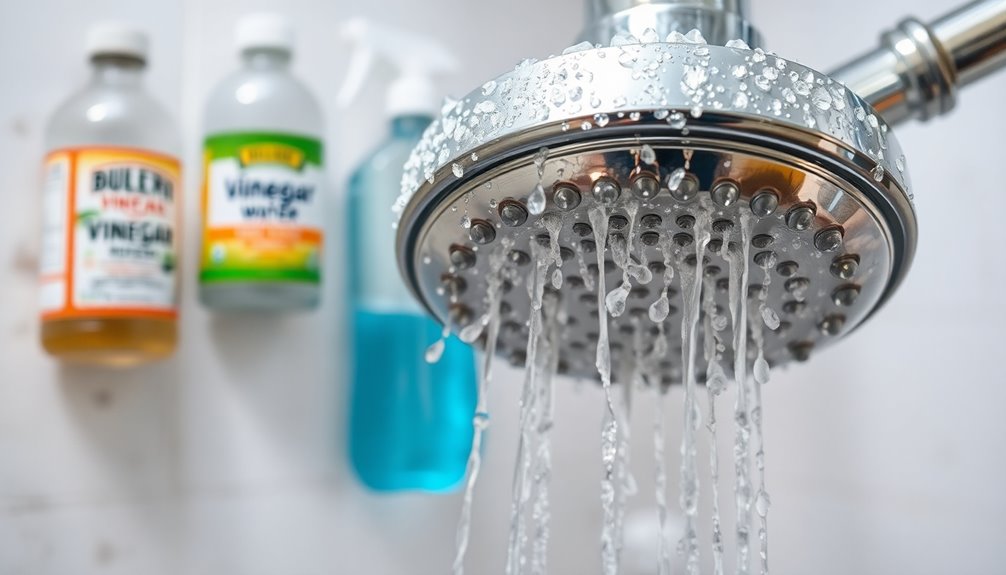
Identifying mineral buildup is just the first step; knowing how to effectively remove it is key to maintaining your home's fixtures and surfaces.
Here are three effective methods to tackle that stubborn buildup of mineral deposits:
- Vinegar Soak: Soak fixtures overnight in vinegar, which contains acetic acid that dissolves limescale and other deposits.
- Citric Acid Cleaning: Use lemon juice or commercial descalers with citric acid to break down magnesium and calcium deposits safely.
- Regular Scrubbing: After soaking, scrub surfaces with non-abrasive pads to remove any remaining mineral deposits.
Natural Solutions for Tackling Mineral Stains
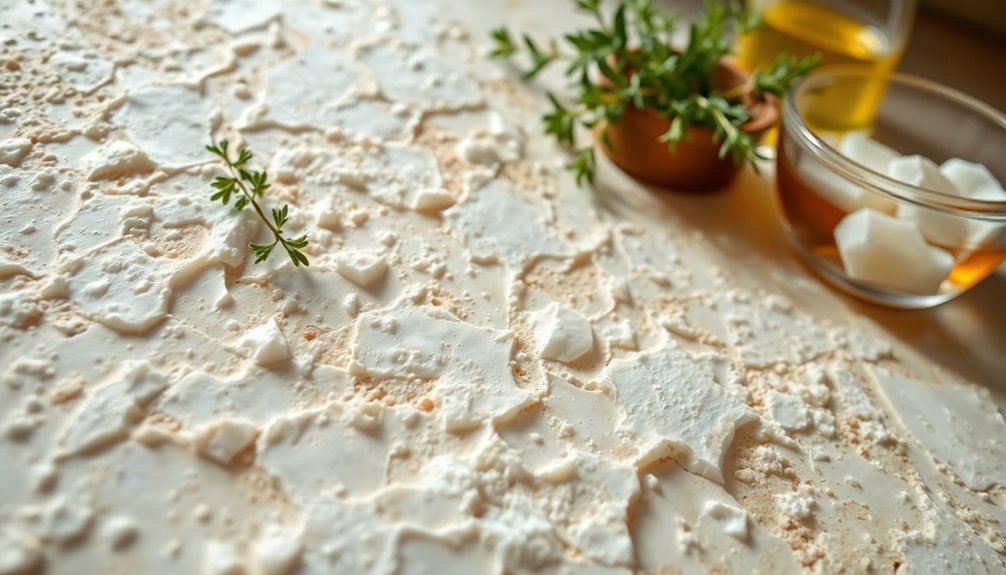
When it comes to tackling mineral stains, natural solutions like vinegar and lemon juice can be game-changers.
You can use vinegar to soak faucets and showerheads, while lemon juice offers citric acid benefits for tougher stains.
Plus, incorporating these preventive measures into your cleaning routine can help you keep surfaces cleaner and minimize future buildup.
Vinegar as a Cleaner
Vinegar serves as an excellent natural solution for tackling mineral stains, as its acetic acid effectively dissolves tough deposits like limescale and hard water stains.
It reacts with calcium carbonate, transforming stubborn stains into soluble compounds that are easy to clean.
Here's how to incorporate vinegar into your cleaning routine:
- Mix equal parts vinegar and water.
- Soak affected surfaces for at least 30 minutes.
- Scrub and rinse for a streak-free shine.
This non-toxic alternative is safe for glass, porcelain, and stainless steel, making it a versatile cleaner.
Regular use of vinegar not only helps remove mineral buildup but also maintains the longevity and efficiency of your appliances and plumbing fixtures.
Citric Acid Benefits
Citric acid stands out as a powerful ally in your fight against mineral stains, particularly limescale. This natural component, found in citrus fruits, effectively dissolves mineral buildup, thanks to its acidic nature. When citric acid interacts with calcium carbonate in limescale, it transforms it into soluble compounds for easy rinsing, restoring your appliances' efficiency. Research shows it can remove up to 90% of limescale deposits, making it a safer alternative to harsh chemicals. Regular use not only aids in the removal of existing stains but also helps prevent future buildup, contributing to appliance longevity.
| Benefits | Details |
|---|---|
| Effective Descaling | Removes up to 90% of limescale deposits |
| Non-Toxic and Eco-Friendly | Safe for households with kids and pets |
| Prevents Future Buildup | Promotes appliance longevity |
Preventive Measures Overview
To keep your appliances and surfaces free from unsightly mineral stains, it's important to adopt preventive measures.
Here's a quick preventive measures overview to help you tackle those pesky stains effectively:
- Use natural solutions: Vinegar or lemon juice can dissolve mineral deposits due to their acidic properties.
- Wipe down surfaces: After any water exposure, quickly wipe down surfaces to prevent high mineral content from leaving crystalline residues.
- Install a water softener: This reduces mineral content in water, considerably mitigating hard water stains throughout your plumbing system.
Preventive Measures to Reduce Mineral Buildup
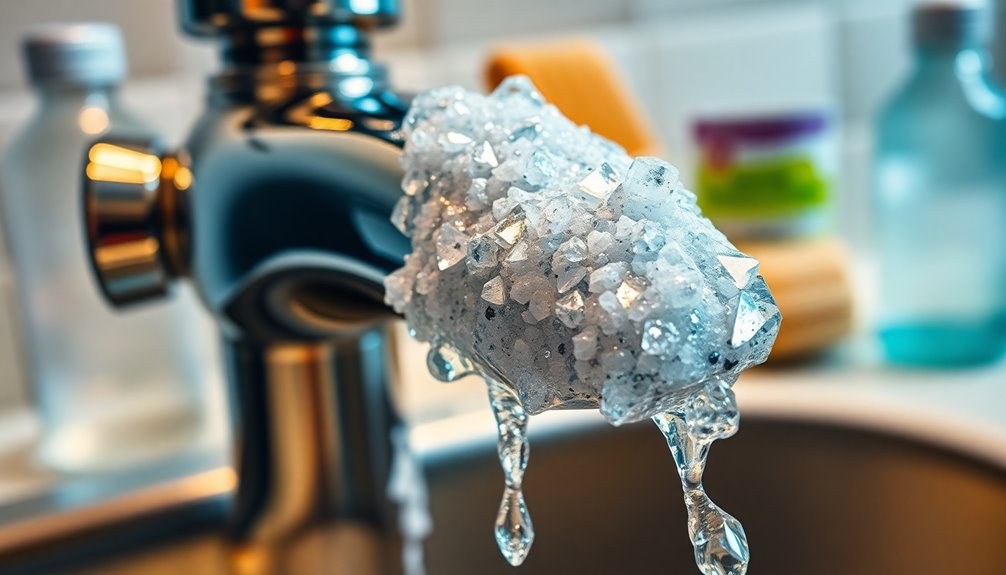
Although mineral buildup can be a persistent issue, there are several effective preventive measures you can take to keep it at bay.
First, consider installing a water softener to reduce calcium and magnesium in your water supply, which directly decreases deposits.
Regularly drying surfaces after water contact is another simple yet efficient tactic; it prevents evaporation that leaves behind concentrated minerals.
Incorporate a consistent cleaning routine using natural cleaners like vinegar or lemon juice, which can help mitigate buildup.
Using a rubber squeegee on glass shower doors after each use will also minimize water residue.
Finally, opt for cleaning solutions with chelating agents, like citric acid, to bind calcium and magnesium ions, making them less likely to form stubborn deposits.
The Role of Water Softeners in Reducing Hardness
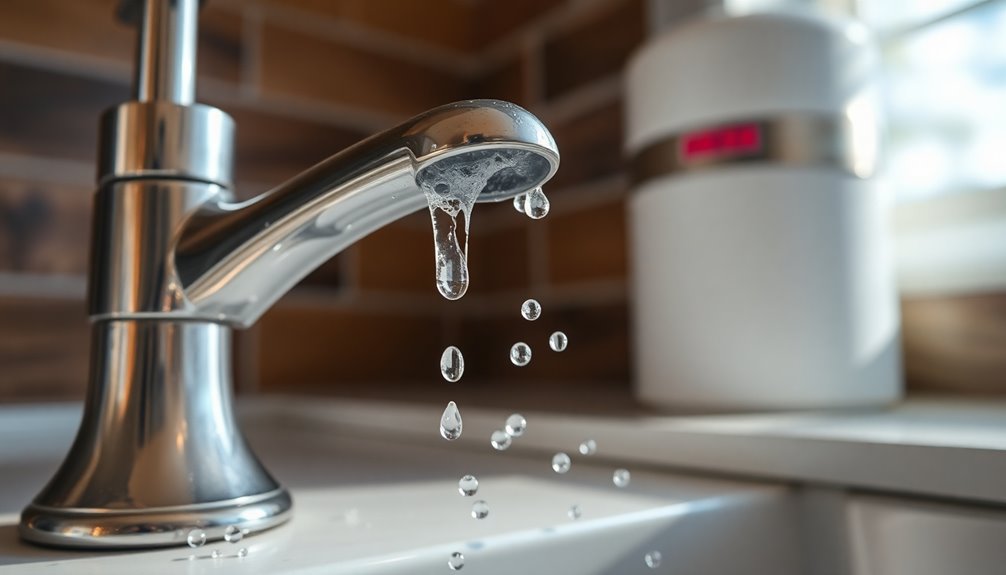
Installing a water softener is one of the most effective steps you can take to combat mineral buildup in your home.
These systems use ion exchange technology to replace calcium and magnesium ions in water with high hardness levels, considerably reducing water hardness.
Here are three benefits of using water softeners:
- Improved Appliance Efficiency: Less limescale means your appliances run at peak performance, avoiding reduced efficiency.
- Cleaner Surfaces: Softened water reduces soap scum, enhancing the effectiveness of your cleaning products.
- Longer Lifespan: With calcium and magnesium minimized, your appliances and plumbing can last longer.
Long-Term Benefits of Regular Maintenance and Cleaning

Regular maintenance and cleaning not only enhance the efficiency of your appliances but also save you money in the long run. By preventing limescale buildup, you can improve heat transfer and cut energy costs by up to 40%. Regular cleaning routines also extend the lifespan of your appliances, avoiding costly repairs. You'll enjoy better-tasting water with fewer contaminants, thanks to consistent upkeep. Plus, tackling hard water stains early keeps your surfaces looking pristine.
| Benefit | Description |
|---|---|
| Improved Efficiency | Reduced energy costs and better performance. |
| Extended Appliance Life | Less frequent repairs and replacements. |
| Enhanced Water Quality | Better taste and reduced contaminants. |
| Fewer Hard Water Stains | Easier maintenance and improved aesthetics. |
| Reduced Cleaning Frequency | Less time spent on cleaning due to preventive measures. |
Frequently Asked Questions
What Causes Mineral Buildup?
Mineral buildup happens mainly because of hard water, which contains high levels of dissolved minerals like calcium and magnesium.
When this water evaporates, it leaves behind deposits that can form on surfaces and appliances.
If you heat water, the minerals precipitate even faster, leading to more buildup.
Additionally, high pH levels can worsen the situation, making it essential for you to manage hard water to prevent these unwanted deposits in your home.
How to Remove Mineral Buildup?
To remove mineral buildup, start by soaking the affected area with vinegar or a commercial descaler.
These solutions break down limescale effectively. If you're using vinegar, let it sit for about 30 minutes.
After soaking, scrub the surface with a brush or cloth to tackle any stubborn residue.
For a natural alternative, you can also use a solution of lemon juice or citric acid.
Regular maintenance will help prevent buildup from returning.
What Is the Science Behind Limescale?
You know how a kettle's always heating up? That's where limescale comes from!
When hard water heats, calcium and magnesium ions bond and form calcium carbonate, which settles as limescale. Higher pH levels make it worse, encouraging those minerals to stick around.
As water evaporates, it leaves behind chalky residues that cling tightly, creating a real headache for you. Regular cleaning is key to keeping your appliances running smoothly and efficiently!
How Is the Process of Forming Minerals From Magma Different From the Formation of Minerals Through the Process of Precipitation?
When you compare the formation of minerals from magma to those formed through precipitation, you'll notice key differences.
Magmatic minerals crystallize rapidly from cooling molten rock, resulting in larger crystals due to high temperatures and pressures.
In contrast, precipitated minerals form slowly as dissolved substances crystallize out of a solution, influenced by environmental factors like temperature and concentration.
This process often leads to smaller, varied crystals that develop over time in surface environments.
Conclusion
In the battle against mineral buildup, you're the hero armed with knowledge and tools. Just like a gardener prunes away weeds to let their flowers thrive, regularly maintaining your appliances and plumbing will keep them running smoothly. Embrace natural solutions and consider water softeners as your trusty sidekick. With these practices, you'll not only enhance your home's efficiency but also enjoy the long-term beauty of a clean, well-maintained environment. Your efforts will pay off in the end!


